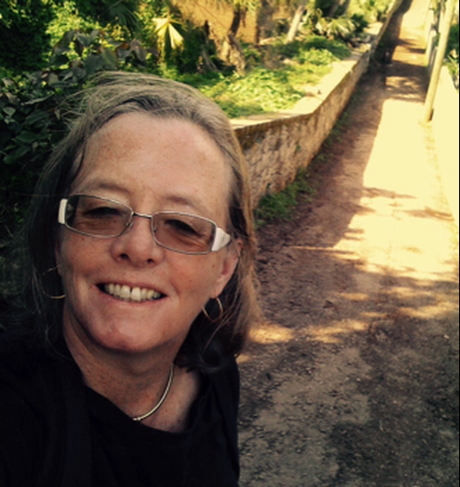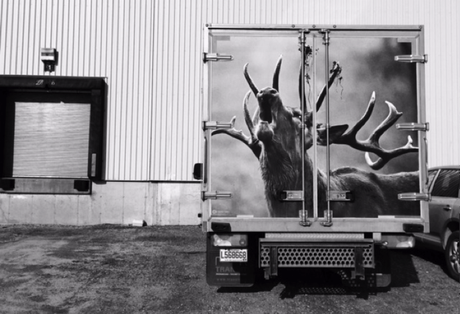
This month, I have the pleasure to welcome Mari Hill Harpur to the blog. Born in St. Paul, Minnesota, in 1949, she has had a passion for art and photography since she was little. Her uncle, Jerome Hill, was an accomplished musician, filmmaker, photographer, and painter.
Cendrine Marrouat: What inspired you to become a photographer?
Mari Hill Harpur: I love visual imagery.
I grew up in an agricultural culture in the American Midwest. I clearly remember walking into my family's upstairs linen closet when the room was awash in a red glow. It had been a nasty messy laundry room and now it was my new darkroom, my very own darkroom! This was to be my place. In it were yellow Kodak envelopes with the chemicals, the trays and thongs, but best of all; I liked staring through the grain finder to focus on one speck of silver in the negative.
Boom! The light in the enlarger exposes the paper. Then follows the first tray, the developer. It was time to watch the image come alive. I held my breath. That was when I was 15 years old. The magic had started.
I spent the rest of that summer mostly in that room. This is where I needed to be and where I belonged. Almost 50 years have elapsed and those stinky trays and analogue adjustments have long ago been replaced by the digital phenomenon. I embraced this transformation in 2000 and I have not exposed a film since then.
In 1967, I moved to Canada to study at Bishop's University in Lennoxville, Quebec, graduating with a BA in humanities in 1971. My interests and my professional life turned out to be divided between the farming and forestry businesses with a focus on land management.
In the meantime, I have had over thirty photographic exhibits internationally. For 20 years I had been a director of the World Forestry Center, Portland, Oregon and retired in 2015. I served as the Chair of WFC from 2003-2006. Additionally, I was a member of the Jerome Foundation for 12 years and a trustee of the Camargo Foundation, Cassis, France for 24 years until I retired in 2013. The last two mentioned foundations support and sponsor various kinds of artistic and creative fellowships and grants.
CM: What makes a good photo?
MHH: In my way of thinking, the recipe for a proper photograph should be to produce an image that points back to an intuitive mind, ideally the photographer's mind. Finally, the image needs one last tweak: the radiant light and the luminosity must be balanced in equal measures. By making the image come alive in this manner, the print will be ready for a frame.
In my early days, not too many of my images succeeded in achieving that desired effect, but some did. Because of that, I kept working at learning to improve. I was to discover that each printed image, regardless of its quality, was a step along the way of enchantment and progress. Lesson learned: never give up!
At 27 years old, I launched my first photographic exhibition of five prints in a branch of the Canadian National Bank in Hudson, Quebec. This small exhibit proved to be my first critical step toward a life of exhibitions in galleries and museums.
Now some 40 years later, I am still exhibiting. Last year, in March 2015, I returned to another bank, the US Bank in Minneapolis, Minnesota and Seattle, Washington, U.S.A. to exhibit a substantially larger exhibition with a printed catalogue with a published book. I felt I had come full circle; from bank to bank. My published book is Creative Non-fiction, 170 pages, with over 150 illustrations. It is published in French and English and the titles are: Sea Winter Salmon: Chronicles of the Saint John River and " Les pèlerins de la rivière Saint-Jean : Chronique de saumons et de saumoniers "
As you already guessed, the book is about a special fish, Salmo salar who migrate thousands of miles in the sea to return into their home waters to spawn. This book talks about one of those 'home rivers' and how the ownership has evolved from fly-fishing for recreation into applying what we have learned from scientific research to today showing we fight hard to protect their environment.
For the past twenty-five years my husband and I have managed the family fishing camp on the Lower North Shore on the Gulf of the St. Lawrence. Contemporary studies show the steady decline in the Salmon salar's population. In a world where fish populations and marine habitats are becoming increasingly marginalized, this book reflects on these phenomena using scientific and photographic data collected over a hundred year period to tell the story about how a river struggles to support its habitat.
CM: What is the photo you prefer in your portfolio? Why?
MHH: Throughout the book are many of my own photographs that were produced over the last few decades. The image below of Deborah looking out to sea demonstrates the scope of the rough Laurentian Shield reaching out and dominating this coastline. Deborah herself is only a small point in the intricate granite landscape. For anyone with an interest in Quebec's history, fly-fishing and a river's ecology, this is a book worth exploring.
CM: What is your favorite subject to photograph?
MHH: Landscape and portraits.
Through my photographic images and conservation advocacy, I try to maintain and protect the extraordinary legacy of the Hill family, their love of fishing and their remarkable contributions to the St. John River area and some of the families who live there. In my book, the photographs help to combine history, biography and biology with the people of the region and their special relationship to the river.
Red Deer Portraits is another subject I have been working on for several years. In 1987 my husband and I first began raising European Red Deer in Canada and later on in Minnesota, USA and New Zealand. By the late 1990s, we were the largest Red Deer farmers on the North American continent.
During the last 30 years, I have frequently exhibited various deer portraits in several galleries and some have been used for book and magazine illustrations. My recent work portrays large landscapes and deer in their habitats in Minnesota, Canada, and New Zealand. A long lens is a must for this type of photography.
Sometimes I find different ways of displaying my photographs. In our venison business, we used one of my photographs to adorn the back of our delivery truck.

In 2010 I was accepted as an Artist in Residence with the Masterworks Foundation in Hamilton, Bermuda with a project titled: Agriculture Today in Bermuda.
Photographing Bermuda's agricultural land and its animals presented me with a challenge. By using black and white photography, how was I to successfully remove the color pallet from this beautiful island and still preserve its splendor? My resulting photographs emphasized the Bermudian landscape in an unusual way.
The final exhibition included photographs of commercialized farming and small-scale family garden plots. I found families who grew the local produce, and who generously included me in their day-to-day operations. The thirty images at the final exhibit at Masterworks was a combination of portraits and landscapes. Lesson learned: always keep an open mind about your subject matter and you will find what you are looking for.
CM: Any photographer you admire?
MHH: Edward Weston, Irving Penn, John Sexton, Ansel Adams, Ruth Bernhard, Dorothea Lang. I am hopelessly traditional.
CM: Anything else you would like to share?
MHH: As a photographer you need to get out and meet people and share new experiences. For example, here is my schedule for a two-week period in April 2016.
Success comes from engaging and exchanging ideas and images. Thank you Cendrine for an opportunity to do just that.
For more information on Mari Hill Harpur, visit www.marihillharpurphotography.com. Interested in being featured in an upcoming post? Feel free to contact me.Posted in: Interviews. Tags: Mari Hill Harpur, wildlife photography.

